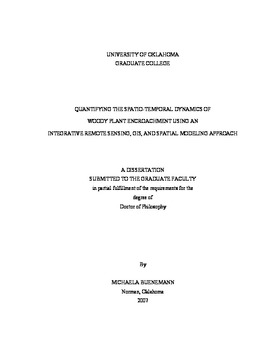| dc.contributor.advisor | Spaeth, Hans-Joachim, | en_US |
| dc.contributor.author | Buenemann, Michaela. | en_US |
| dc.date.accessioned | 2013-08-16T12:20:34Z | |
| dc.date.available | 2013-08-16T12:20:34Z | |
| dc.date.issued | 2007 | en_US |
| dc.identifier.uri | https://hdl.handle.net/11244/1153 | |
| dc.description.abstract | Despite a longstanding universal concern about and intensive research into woody plant encroachment (WPE)---the replacement of grasslands by shrub- and woodlands---our accumulated understanding of the process has either not been translated into sustainable rangeland management strategies or with only limited success. In order to increase our scientific insights into WPE, move us one step closer toward the sustainable management of rangelands affected by or vulnerable to the process, and identify needs for a future global research agenda, this dissertation presents an unprecedented critical, qualitative and quantitative assessment of the existing literature on the topic and evaluates the utility of an integrative remote sensing, GIS, and spatial modeling approach for quantifying the spatio-temporal dynamics of WPE. | en_US |
| dc.description.abstract | In sum, this dissertation demonstrates that integrative remote sensing, GIS, and spatial modeling approaches have enormous potential for addressing questions relevant to both rangelands research and management. However, it also suggests that much work remains to be done before we can translate our understanding of WPE into sustainable rangeland management strategies. In particular, we need to more fully explore the limitations and potentials of currently available data and techniques for quantifying WPE; build structures for data sharing and integration; develop a set of relevant standards; more actively engage in collaborative research efforts; and foster cross-cutting dialogues among researchers, managers, and communities. | en_US |
| dc.description.abstract | Specifically, this research demonstrates that the application of cutting-edge remote sensing techniques (Multiple Endmember Spectral Mixture Analysis, fuzzy logic-based change detection) to conventional medium spatial and spectral resolution imagery (Landsat Thematic Mapper, Landsat Enhanced Thematic Mapper Plus, ASTER) can be used to generate spatially explicit estimates of temporal changes in the abundance of woody plants and other surface materials. The research also shows that spatial models (Geographically Weighted Regression, Weights of Evidence, Weighted Logistic Regression) integrating this timely remotely sensed information with readily available GIS data can yield reasonably accurate estimates of an area's relative vulnerability to WPE and of the importance of anthropogenic and geoecological variables influencing the process. Such models may also be used for the testing of existing and generation of new scientific hypotheses about WPE, for evaluating the impact of natural or human-induced modifications of a landscape on the landscape's vulnerability to WPE, and for identifying target areas for conservation, restoration, or other management objectives. | en_US |
| dc.description.abstract | Findings from this research suggest that gaps in our current understanding of WPE and difficulties in devising sustainable rangeland management strategies are in part due to the complex spatio-temporal web of interactions between geoecological and anthropogenic variables involved in the process as well as limitations of presently available data and techniques. However, an in-depth analysis of the published literature also reveals that aforementioned problems are caused by two further crucial factors: the absence of information acquisition and reporting standards and the relative lack of long-term, large-scale, multi-disciplinary research efforts. The methodological framework proposed in this dissertation yields data that are easily standardized according to various criteria and facilitates the integration of spatially explicit data generated by a variety of studies. This framework may thus provide one common ground for scientists from a diversity of fields. Also, it has utility for both research and management. | en_US |
| dc.format.extent | xix, 448 leaves : | en_US |
| dc.subject | Environmental Sciences. | en_US |
| dc.subject | Rangelands Monitoring Oklahoma Beckham County. | en_US |
| dc.subject | Remote Sensing. | en_US |
| dc.subject | Woody plants Oklahoma Beckham County. | en_US |
| dc.subject | Physical Geography. | en_US |
| dc.title | Quantifying the spatio-temporal dynamics of woody plant encroachment using an integrative remote sensing, GIS, and spatial modeling approach. | en_US |
| dc.type | Thesis | en_US |
| dc.thesis.degree | Ph.D. | en_US |
| dc.thesis.degreeDiscipline | Department of Geography and Environmental Sustainability | en_US |
| dc.note | Adviser: Hans-Joachim Spaeth. | en_US |
| dc.note | Source: Dissertation Abstracts International, Volume: 68-01, Section: B, page: 0171. | en_US |
| ou.identifier | (UMI)AAI3249640 | en_US |
| ou.group | College of Atmospheric & Geographic Sciences::Department of Geography and Environmental Sustainability | |
